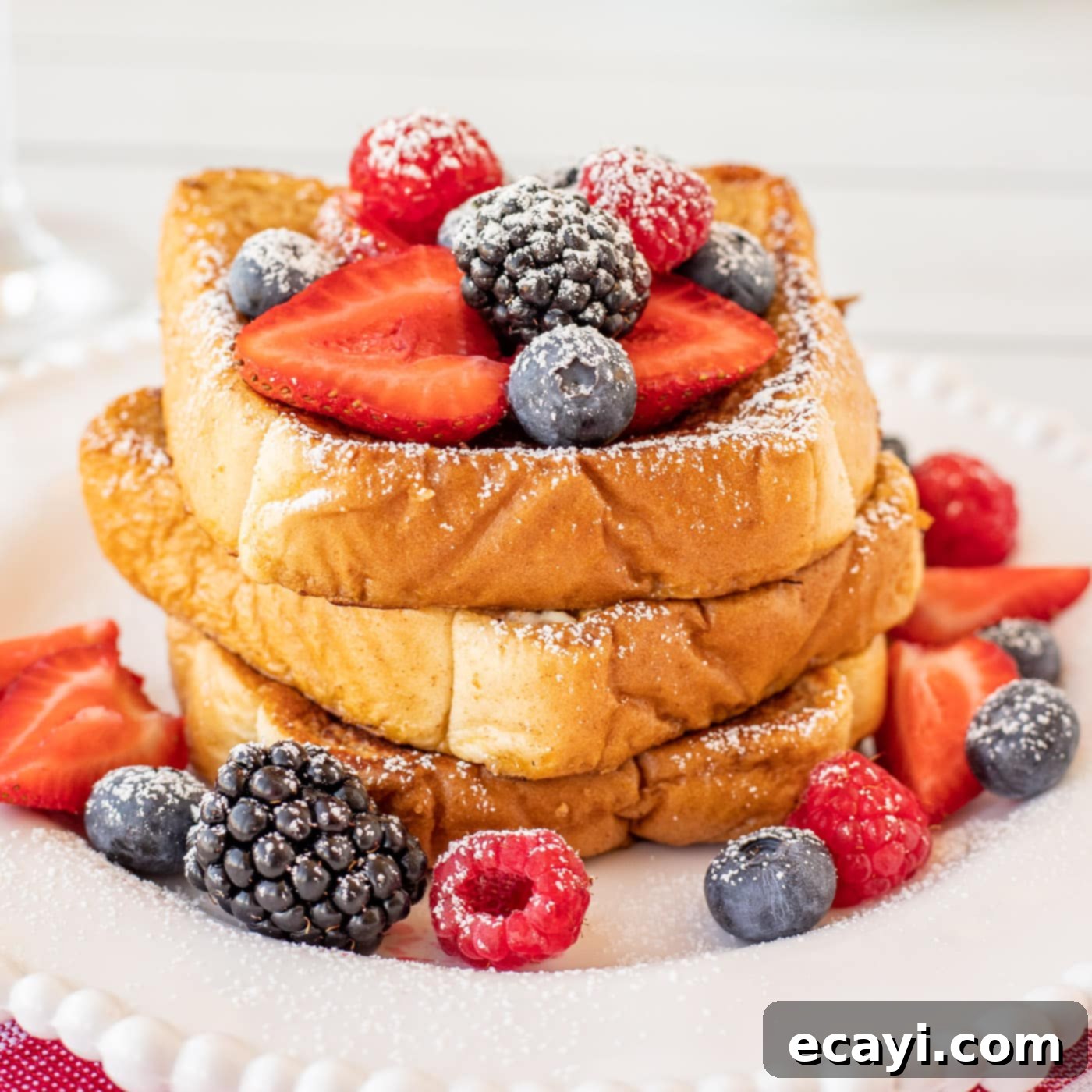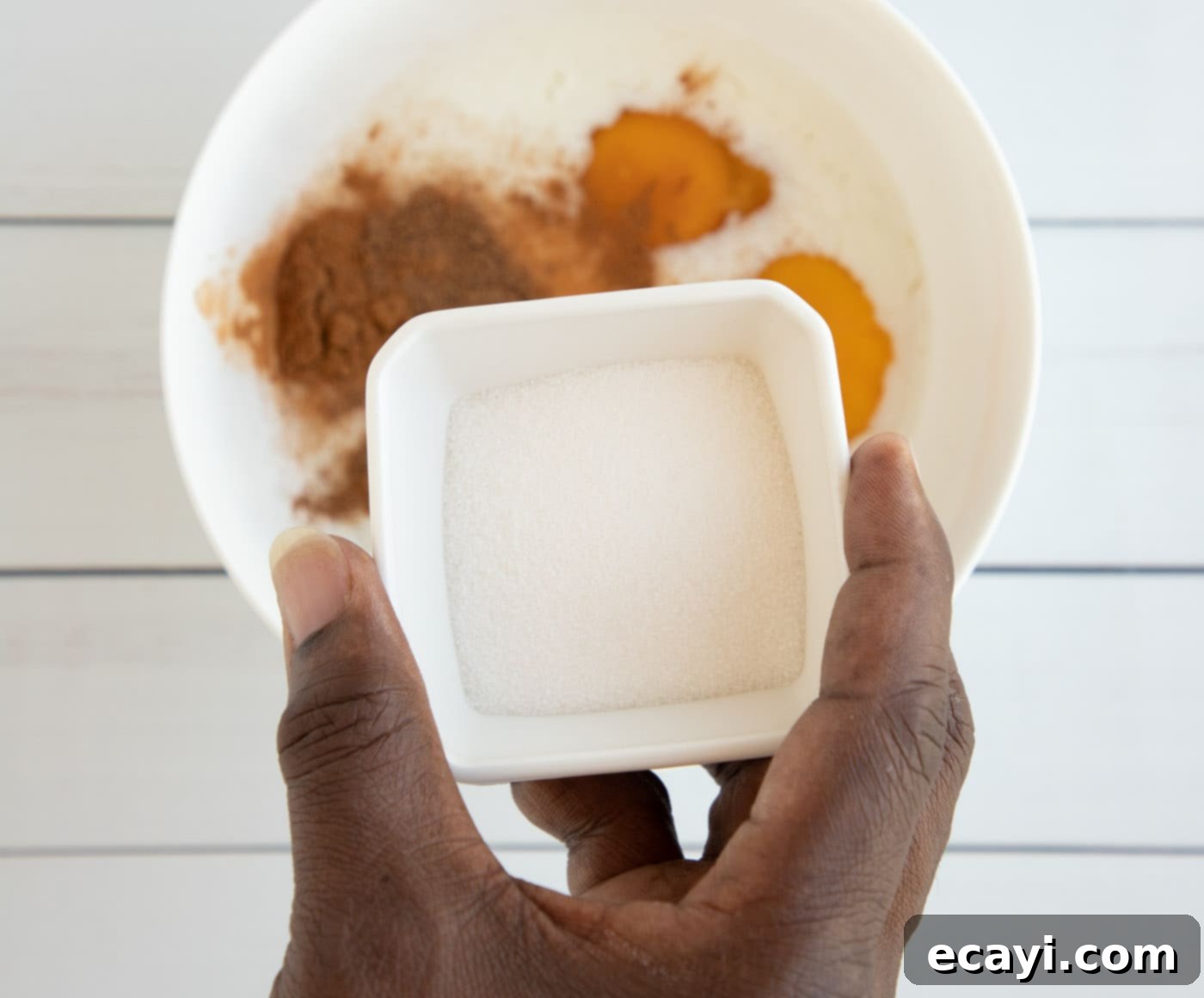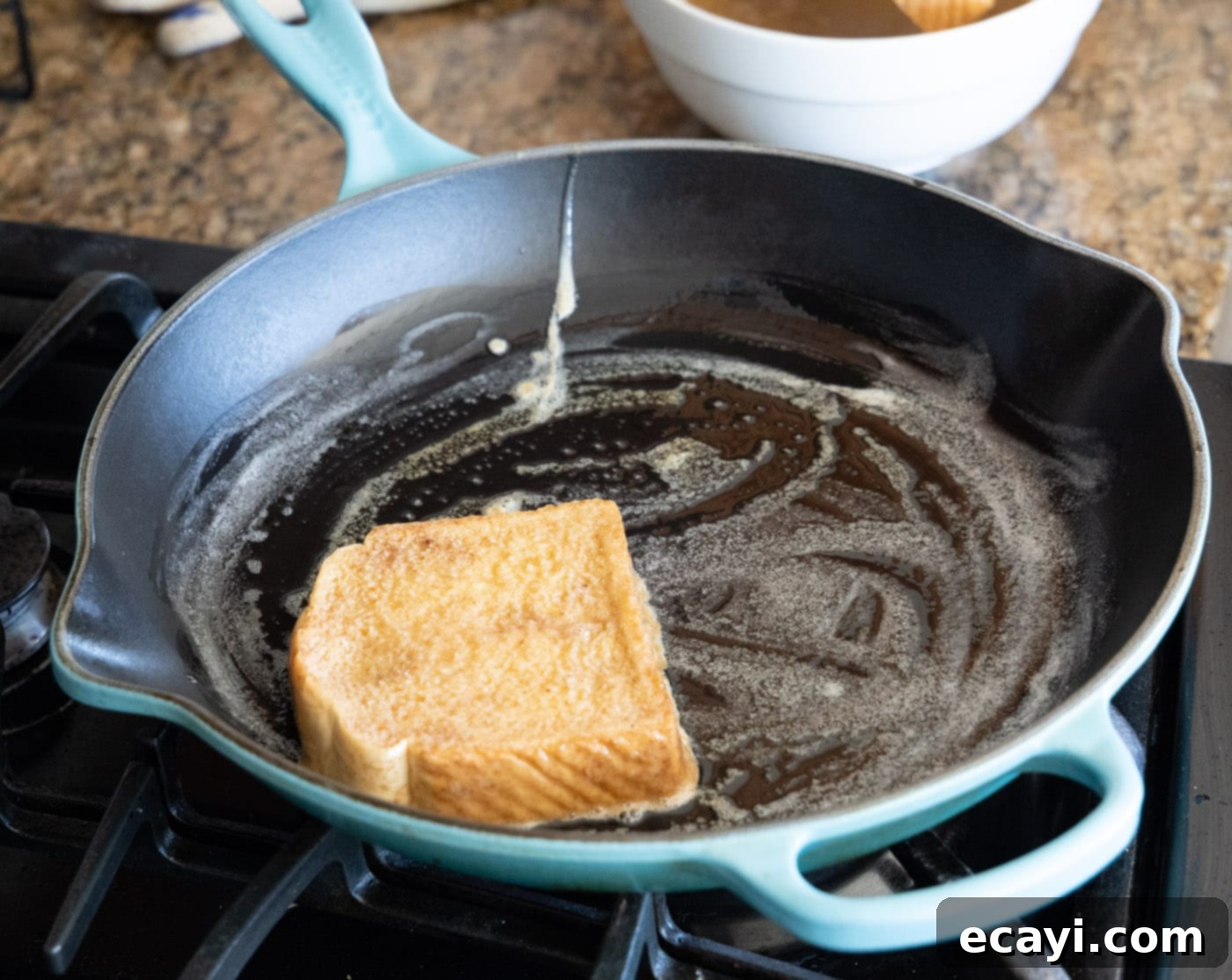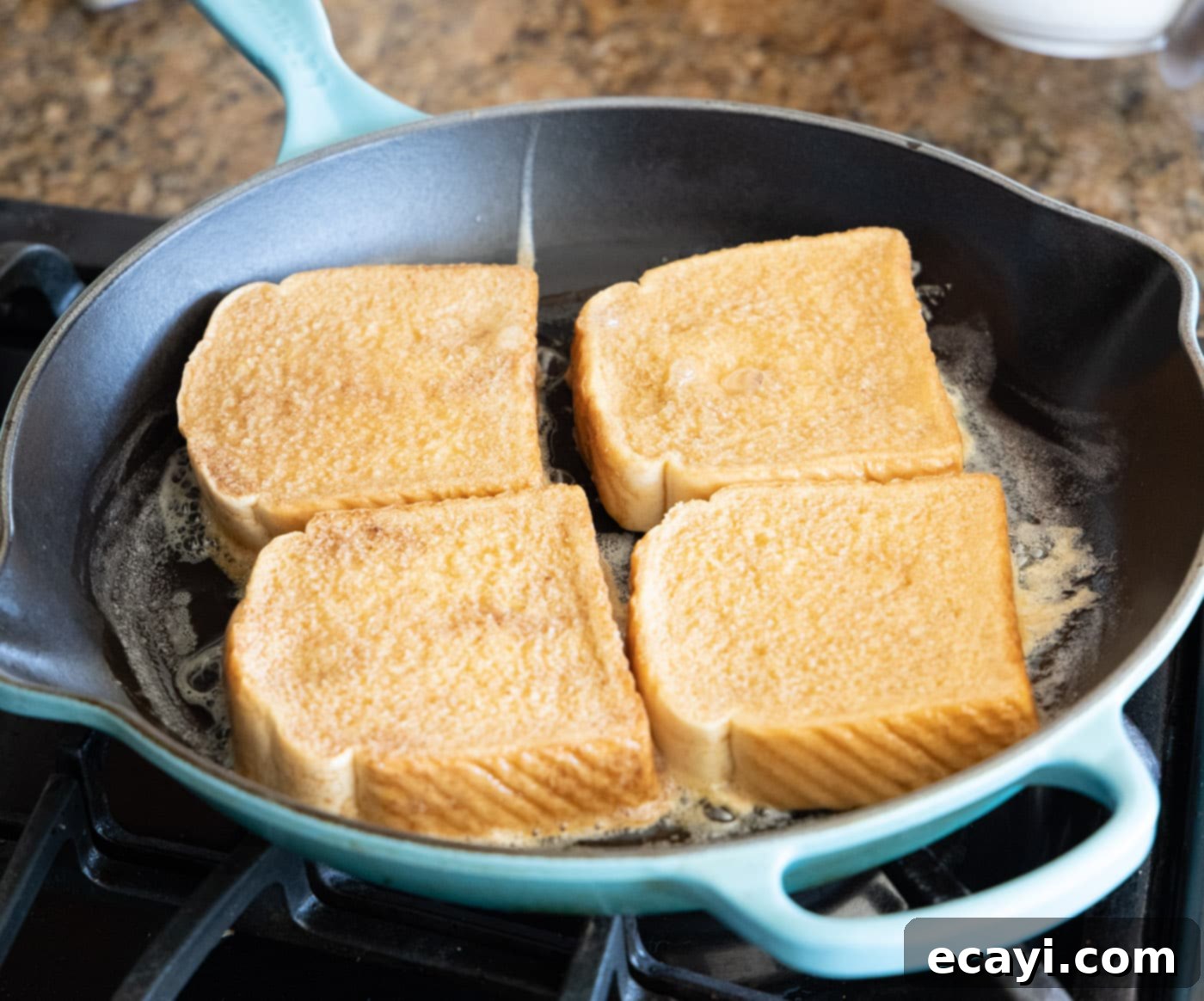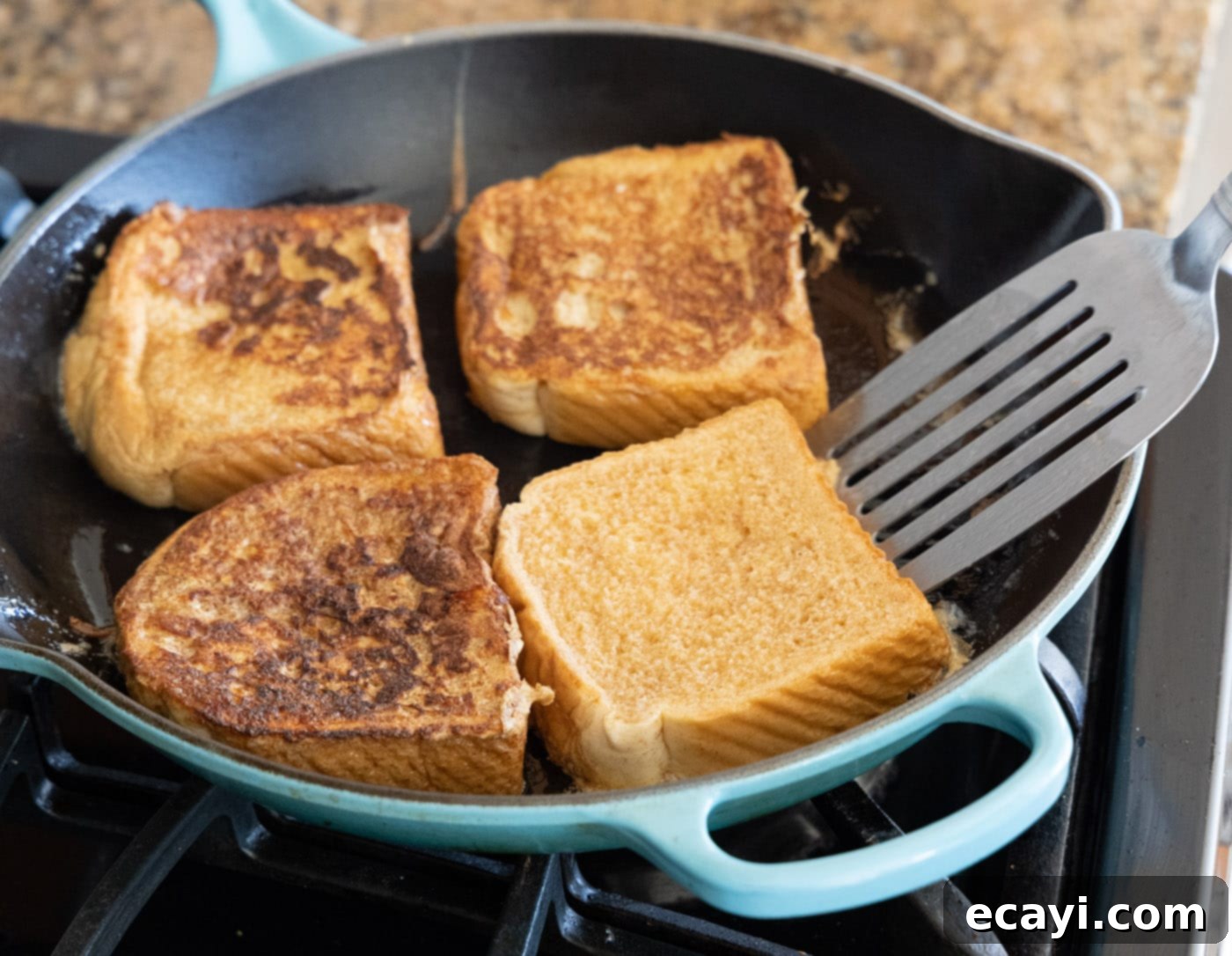The Ultimate Fluffy French Toast Recipe: Your 10-Minute Breakfast Go-To
Prepare to elevate your breakfast game with this incredibly thick, irresistibly fluffy French toast recipe. Each slice is generously dipped in a warmly spiced mixture of fragrant nutmeg, comforting cinnamon, and rich maple syrup, then perfectly pan-fried to a delicate, golden-brown crispness. This isn’t just any French toast; it’s set to become your new favorite go-to recipe for an easy, delightful morning meal that comes together in as little as 10 minutes!
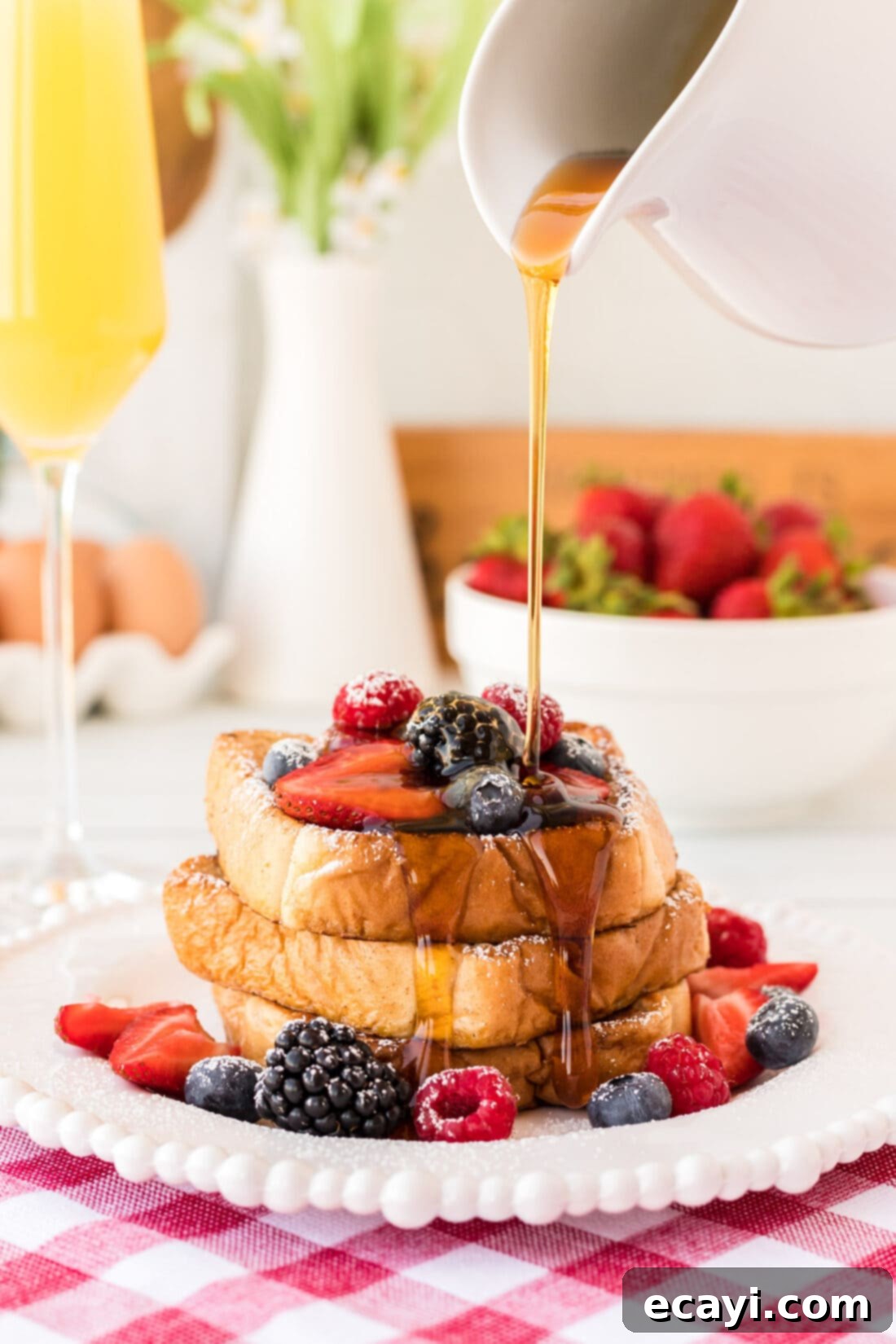
Why This French Toast Recipe Works Wonders
Among the pantheon of beloved breakfast classics, from savory breakfast casseroles to light and airy buttermilk pancakes, French toast holds a special place. It’s a dish synonymous with comfort, warmth, and a touch of indulgence – especially when generously smothered in sticky, sweet maple syrup and crowned with a melting pat of butter. Our French toast recipe, however, stands out for several compelling reasons, making it an absolute must-try for any breakfast enthusiast.
Firstly, the foundation of our exceptional French toast lies in the bread choice: thick-cut Texas toast. This robust bread is perfect for absorbing the rich custard mixture without becoming soggy, ensuring a substantial, satisfying bite every time. The generous thickness allows for a beautiful contrast between the crispy, golden exterior and the soft, almost custardy interior. Each slice undergoes a luxurious dip into a meticulously crafted mixture of farm-fresh eggs, wholesome milk, pure maple syrup for natural sweetness, aromatic cinnamon, a hint of earthy nutmeg, and a touch of granulated sugar. This perfectly balanced batter infuses the bread with incredible flavor and moisture.
Once thoroughly coated, these magnificent slices are gently transferred to a hot, buttered skillet, where they sizzle away to perfection. The high heat creates a lightly crisp, caramelized crust on the outside, while the interior remains incredibly soft and wonderfully fluffy. The quick cooking time, combined with simple ingredients and straightforward steps, makes this an ideal recipe for a quick weekday morning treat or a leisurely weekend brunch. It’s truly a testament to how a few quality ingredients and a well-tested method can transform humble bread into an extraordinary culinary experience.
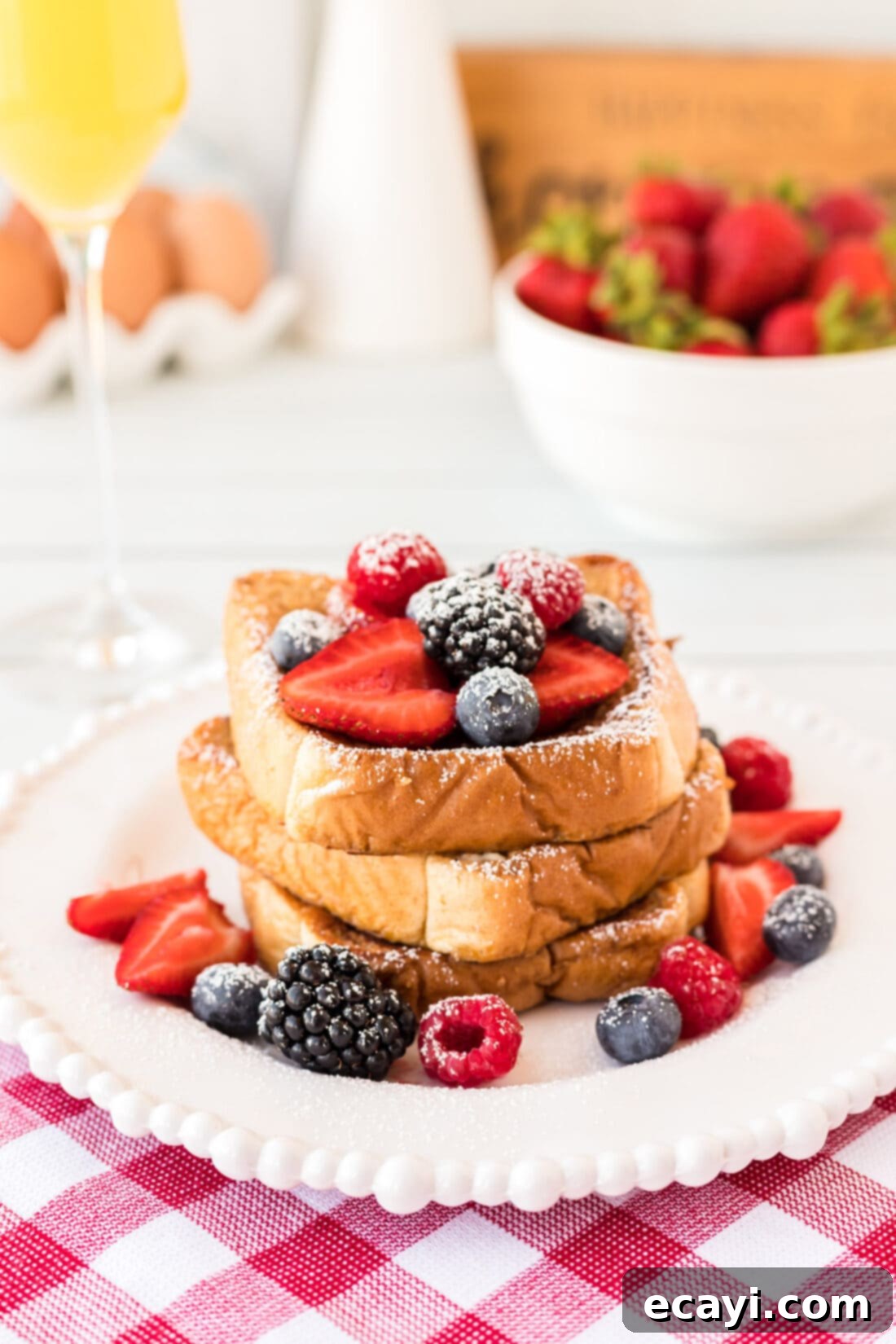
Essential Ingredients for Perfect French Toast
Crafting the perfect batch of fluffy French toast requires just a few basic ingredients, most of which you likely already have in your pantry and refrigerator. The beauty of this recipe lies in its simplicity and the way these humble components combine to create something truly magical. For all precise measurements and a comprehensive list of ingredients, along with step-by-step instructions, please refer to the printable recipe card available at the end of this post.
Before you begin, gather these key components to ensure a smooth and enjoyable cooking process. Having everything measured and ready will make your 10-minute French toast experience even quicker and more stress-free!
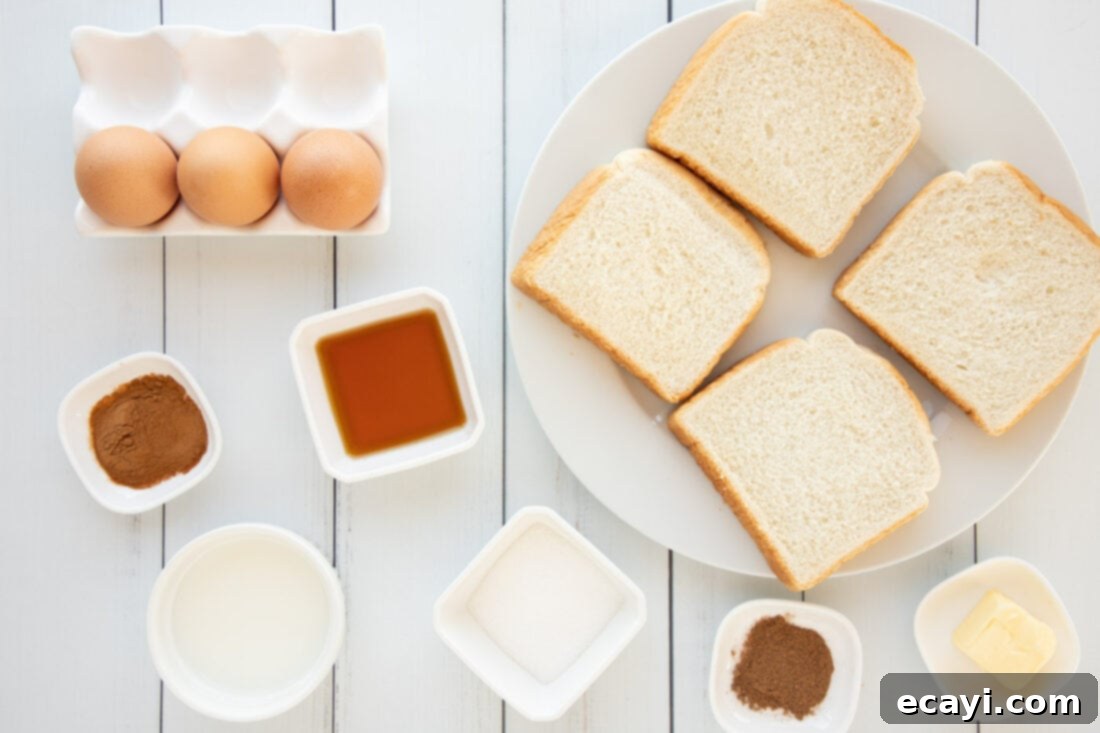
Ingredient Spotlight & Smart Substitutions
Understanding each ingredient’s role can help you master this classic breakfast and even customize it to your liking. Here’s a closer look at the components of our French toast:
BREAD – The bread is the star of the show, and its quality significantly impacts the final texture of your French toast. While we heartily recommend thick Texas toast for its incredible ability to absorb the custard without falling apart, several other types of bread also make excellent choices. Challah and Brioche are particularly popular options; their slightly sweet, rich, and eggy crumb makes for a decadent French toast. You can even use regular white sandwich bread if that’s what you have on hand, though we suggest choosing a slightly thicker slice if possible. The thicker the slice, the more pronounced the contrast between the crispy exterior and the tender interior – a hallmark of truly great French toast!
Pro Tip for Bread: Day-old or slightly stale bread works best! Fresh bread tends to absorb too much liquid too quickly and can become mushy. Stale bread holds its structure better while still soaking up all that delicious custard.
EGGS – Large eggs are crucial for creating the rich, custardy base of the dipping mixture. They bind the ingredients together and, when cooked, give French toast its signature tender texture. We recommend using large eggs for consistency, but if you only have medium or jumbo, adjust the milk slightly to maintain the right consistency.
MILK – Any type of milk can be used, from whole milk for a richer result to skim milk for a lighter version, or even non-dairy alternatives like almond milk or oat milk for dietary preferences. The milk helps thin out the egg mixture, ensuring it coats the bread evenly and keeps it moist.
MAPLE SYRUP – Pure maple syrup adds a depth of flavor and natural sweetness that artificial syrups simply can’t match. It’s incorporated directly into the batter to infuse every bite with its distinct taste. If you don’t have maple syrup, honey or a simple syrup (equal parts sugar and water, heated until dissolved) can be used, though the flavor profile will differ.
SPICES (CINNAMON & NUTMEG) – These warm spices are the secret to that irresistible, comforting aroma and flavor. Ground cinnamon and nutmeg complement each other beautifully, adding a cozy warmth. Feel free to adjust the amounts to your personal preference, or experiment with other spices like a pinch of allspice, cardamom, or even a tiny dash of clove for an extra layer of complexity.
GRANULATED SUGAR – A little extra sugar in the batter helps with caramelization and provides additional sweetness, enhancing the overall flavor. You can adjust the amount based on how sweet you prefer your French toast or if you plan on adding very sweet toppings.
BUTTER – Essential for pan-frying, butter not only prevents sticking but also imparts a rich, nutty flavor and contributes to that beautiful golden-brown crust. We recommend unsalted butter so you can control the salt content of your dish, but salted butter works in a pinch.
Crafting Your Perfect French Toast: Step-by-Step
These step-by-step photos and detailed instructions are provided to help you visualize exactly how to make this delightful French toast recipe. For your convenience, you can Jump to Recipe to access the printable version, complete with precise measurements and instructions, located at the bottom of this page.
- Prepare the Custard Mixture: In a medium-sized bowl, combine the eggs, milk, maple syrup, ground cinnamon, nutmeg, and granulated sugar. Whisk these ingredients together vigorously until they are thoroughly combined and the mixture is smooth. Ensure there are no streaks of egg white remaining. This creates the flavorful custard that will infuse your bread with richness and spice.

- Heat the Skillet: Place a skillet (preferably non-stick or cast iron) over medium heat. Add the butter and allow it to melt completely. Swirl the pan to ensure the melted butter generously coats the entire bottom surface. This buttery coating is key for preventing sticking and creating a beautiful golden crust. Maintain medium heat; if the pan is too hot, the French toast will burn before cooking through, and if it’s too cool, it won’t achieve that desirable crispness.
- Dip and Cook the Bread: Take one slice of your chosen bread (Texas toast is recommended for its thickness) and gently place it into the prepared egg mixture. Allow it to soak for about 10-15 seconds per side for regular bread, or up to 30 seconds for very thick slices like Texas toast or brioche. Ensure both sides are well coated. Lift the bread out of the mixture, allowing any excess liquid to drip back into the bowl to prevent a soggy outcome. Carefully transfer the soaked slice to the hot, buttered skillet. Repeat this process for each subsequent slice, making sure not to overcrowd the pan. Cook in batches if necessary to ensure even browning.


- Achieve Golden Perfection: Cook the French toast on the first side for approximately 2 minutes, or until it develops a beautiful, rich golden-brown color and a lightly crisp texture. Using a spatula, carefully flip the slices over to the second side. Cook for an additional 2 minutes, or until that side also turns a glorious golden brown. The total cooking time may vary slightly depending on your stove and the thickness of your bread, so keep an eye on it for perfect results. Once cooked, transfer the finished slices to a warm plate and repeat with any remaining bread.

Frequently Asked Questions & Expert Tips
Absolutely! Freezing homemade French toast is a fantastic way to prepare ahead for quick breakfasts. We highly recommend pre-cooking the French toast completely before freezing. Once cooked, allow the French toast to cool fully to room temperature. This prevents ice crystals from forming excessively. Then, transfer the cooled slices to a large freezer-safe zip-top bag or an airtight container, ensuring they are separated by parchment paper if stacking to prevent sticking. Label the bag or container with the date. French toast can be frozen for up to 2 months. To reheat, you have a couple of easy options: place the frozen slices on a baking tray and warm them in an oven preheated to 400°F (200°C) for around 7-8 minutes, or simply pop the slices into a toaster or toaster oven until heated through and slightly crispy.
More Expert Tips for Flawless French Toast:
- Don’t Over-Soak Thin Bread: While thick bread benefits from a good soak, thinner slices can become mushy if left in the custard for too long. A quick dip, just enough to coat, is often sufficient.
- Consistent Heat is Key: Keep your skillet at a consistent medium heat. Too high, and the outside will burn while the inside remains uncooked. Too low, and the toast will absorb too much fat and become greasy without getting a nice crust.
- Use a Wide, Shallow Dish for Dipping: A baking dish or pie plate is ideal for dipping bread slices, allowing them to lie flat and soak evenly without breaking.
- Batch Cooking for Crowds: If you’re making French toast for a large group, you can keep cooked slices warm in a single layer on a baking sheet in a low oven (around 200°F / 95°C) while you finish cooking the rest.
- Add a Splash of Vanilla: For an extra layer of flavor, a teaspoon of vanilla extract can be a wonderful addition to the egg mixture.
- Dairy-Free Option: Easily make this recipe dairy-free by substituting regular milk with your favorite unsweetened non-dairy milk (almond, soy, or oat milk work well) and using a plant-based butter alternative.
- Egg-Free (Vegan) French Toast: For an egg-free version, consider using a “flax egg” (1 tbsp ground flaxseed meal + 3 tbsp water per egg, let sit for 5 minutes) or a commercial egg replacer in the custard mixture, combined with plant-based milk. The texture will be slightly different but still delicious.
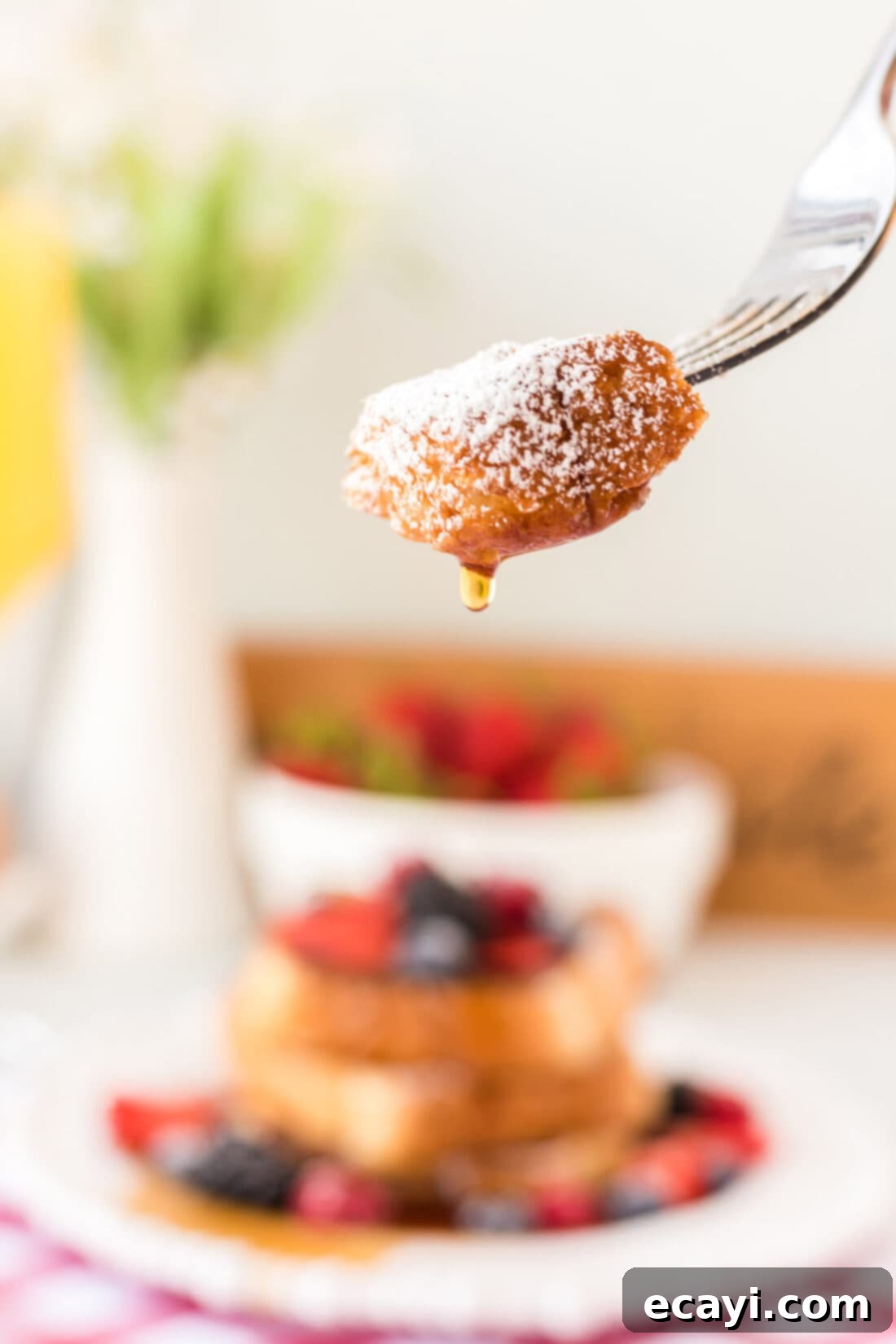
Delightful Serving Suggestions for Your French Toast
While a simple drizzle of maple syrup and a melting pat of butter are undoubtedly classic and delicious, French toast is incredibly versatile and lends itself beautifully to a wide array of toppings and accompaniments. Get creative and customize your French toast experience!
Sweet Topping Ideas:
- Classic & Simple: A light dusting of powdered sugar adds an elegant touch, enhancing the sweetness without overpowering it.
- Fresh Berries: Brighten up your plate with a colorful medley of fresh strawberries, blueberries, raspberries, or blackberries. Their natural sweetness and slight tartness provide a refreshing contrast.
- Sliced Fruits: Beyond berries, consider sliced bananas, peaches, or even caramelized apples for a comforting autumnal twist.
- Whipped Cream or Crème Fraîche: A dollop of freshly whipped cream or tangy crème fraîche adds a luxurious, creamy texture.
- Nut Butters & Spreads: For a more substantial and protein-packed option, spread a layer of peanut butter, almond butter, or decadent Nutella on your French toast.
- Flavored Syrups & Sauces: Experiment with different types of syrups beyond maple, such as blueberry syrup, chocolate sauce, or a homemade fruit compote. You could also try our irresistible cinnamon honey butter for an extra layer of spiced sweetness.
- Toasted Nuts: A sprinkle of chopped toasted pecans, walnuts, or almonds adds a delightful crunch.
Savory Pairings for a Balanced Meal:
For those who love a sweet and savory combination, French toast pairs wonderfully with:
- Crispy bacon or breakfast sausage links.
- A fried or poached egg on the side.
- A sprinkle of fresh herbs like mint or basil for an unexpected but delightful fresh note.
Whether you’re serving it for a leisurely breakfast or a festive brunch, French toast is always a crowd-pleaser. Don’t forget to pair it with a refreshing beverage like coffee, tea, or a sparkling mimosa for the ultimate brunch experience!
Explore More Delicious Breakfast Recipes
If you loved this French toast recipe, you’re in for a treat! Our kitchen is filled with an abundance of fantastic breakfast and brunch ideas to satisfy every craving. From hearty and savory to sweet and indulgent, there’s something for everyone to enjoy. Expand your morning meal repertoire with these other tried-and-true recipes:
- Crispy Chicken and Waffles
- Classic Eggs Benedict
- Fluffy Blueberry Muffins
- Irresistible Homemade Cinnamon Rolls
- Decadent Strawberries and Cream Stuffed French Toast
- Easy Cinnamon Roll Casserole
I absolutely adore spending time in the kitchen, creating and perfecting recipes, and then sharing those culinary adventures with all of you! Remembering to visit back each day for new inspiration can sometimes be a challenge, which is why I’ve made it simple for you. I offer a convenient newsletter delivered directly to your inbox every time a new recipe is posted. Simply subscribe today and start receiving your free daily recipes – never miss another delicious creation!
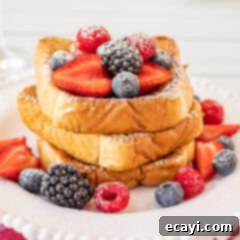
French Toast
IMPORTANT – There are often Frequently Asked Questions within the blog post that you may find helpful. Simply scroll back up to read them!
Print It
Pin It
Rate It
Save ItSaved!
Ingredients
- 4 slices Texas toast bread
- 3 large eggs
- ½ cup milk
- 2 Tablespoons maple syrup
- ½ teaspoon nutmeg
- 1 teaspoon ground cinnamon
- 2 Tablespoons granulated sugar
- 1 Tablespoons butter
Things You’ll Need
-
Large skillet
-
Vinyl gloves
Before You Begin
- Garnish your French Toast with powdered sugar, syrup and/or fresh berries.
- To Freeze: I would recommend pre-cooking the French toast before freezing. Allow the french toast to fully cool before transferring to a large ziptop bag labeled with the date. Freeze for up to 2 months. To reheat, place the frozen French toast on a baking tray and warm it in the oven set to 400F for around 7-8 minutes OR simply pop the slices into a toaster or toaster oven.
Instructions
-
In a medium bowl whisk together, eggs, milk, maple syrup, cinnamon, nutmeg, and sugar.
-
Melt butter in a skillet over medium heat, ensuring that the butter coats the entire bottom of the pan.
-
Place a slice of bread into the egg mixture and turn to coat both sides. Lift out of the mixture and allow the excess to drip off, then place in hot buttered skillet. Repeat for all bread slices.
-
Cook on the first side for about 2 minutes, or until nicely browned. Flip slices and cook an additional 2 minutes, or until golden brown.
Nutrition
The recipes on this blog are tested with a conventional gas oven and gas stovetop. It’s important to note that some ovens, especially as they age, can cook and bake inconsistently. Using an inexpensive oven thermometer can assure you that your oven is truly heating to the proper temperature. If you use a toaster oven or countertop oven, please keep in mind that they may not distribute heat the same as a conventional full sized oven and you may need to adjust your cooking/baking times. In the case of recipes made with a pressure cooker, air fryer, slow cooker, or other appliance, a link to the appliances we use is listed within each respective recipe. For baking recipes where measurements are given by weight, please note that results may not be the same if cups are used instead, and we can’t guarantee success with that method.
